
Introduction
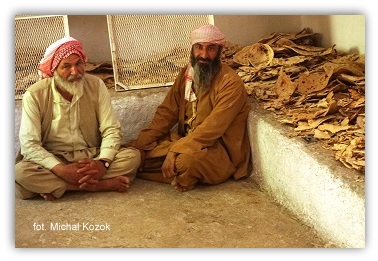 I usually associated Iraq with news about attacks, war and the aggression of the Islamic State. That is how it is presented on television. But of course like everywhere, apart from this whole "evil", everyday life dominates with full of worries and hardworking, peace of mind and hope for a better tomorrow. After all, the locals are the most common victims of mass murders and violence used on their own land. They also want to live in peace.
I usually associated Iraq with news about attacks, war and the aggression of the Islamic State. That is how it is presented on television. But of course like everywhere, apart from this whole "evil", everyday life dominates with full of worries and hardworking, peace of mind and hope for a better tomorrow. After all, the locals are the most common victims of mass murders and violence used on their own land. They also want to live in peace.
However I didn't go to Iraq itself. I would not even get a visa there too easy, I would not cross the Iraq/Kurdish border. I went to Kurdistan, an autonomous Iraqi unit, with its own government, president, army, etc. Kurdistan recognizes Iraq's supremacy in exchange for 20% of Iraqi oil sales revenue. It all comes down to money :( There are around 25 million Kurds worldwide, of which Iraq is home to around 1/5. This is one of the largest nations in the world without their own independent country.

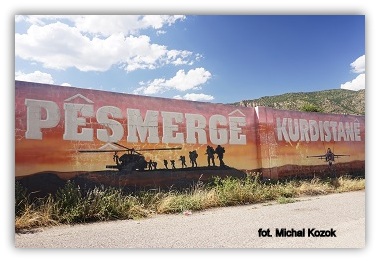

Day 1
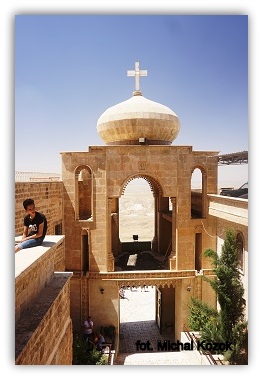 Mar Mattai Monastery was the first object on our route. It is one of the oldest Christian monasteries in the world, from 363 AC, but at the moment most of the construction has been renovated, so it has lost its ancient character. The destruction of buildings should not come as a surprise, because the monastery was often plundered and attacked, including the conflict with the Islamic State in 2015. From the hill of the monastery you can see the hilly terrain along which the recent war front line. Just behind it, less than 30 km from the place where we stood, is the city of Mosul, which suffered a lot. The monastery is pleasant, you can feel the religious atmosphere including lapping the collar around the neck, the smell of incense, the picnic atmosphere of multi-generation local families.
Mar Mattai Monastery was the first object on our route. It is one of the oldest Christian monasteries in the world, from 363 AC, but at the moment most of the construction has been renovated, so it has lost its ancient character. The destruction of buildings should not come as a surprise, because the monastery was often plundered and attacked, including the conflict with the Islamic State in 2015. From the hill of the monastery you can see the hilly terrain along which the recent war front line. Just behind it, less than 30 km from the place where we stood, is the city of Mosul, which suffered a lot. The monastery is pleasant, you can feel the religious atmosphere including lapping the collar around the neck, the smell of incense, the picnic atmosphere of multi-generation local families.
Then we went to the holiest place of the Yazidis - Lalish. Yezidism is a religion that combines Islam and Christianity. The land is holy for them, they walk barefoot, cannot spit, do not recognize violence (that is why they do not fight in the Kurdish army - Peshmerg), and unfortunately they are persecuted, recently they were very brutally treated and murdered by terrorists from Islamic State. We loved Lalish, because it was a living, natural place, we managed to mix up with the crowd, be invited for a tea, chat, or getting crazy at the photographic session during the local children baptism.
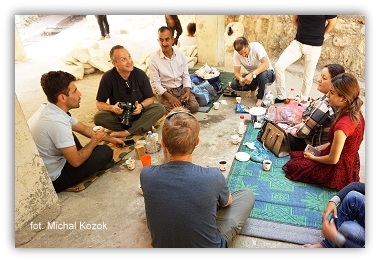

 Quite nearby there is Khanis, where the local boys swim in the greenish Gomel River. They jump into the water from the shore, and some of the old rocks on which these boys are standing, still bear the clear antique bas-reliefs. The hills dominate above the river, and on some of them you can see the tombs carved in the rock. You could climb to those on the lower level. This place is a remnant of the Assyrian Empire, and the tombs themselves date back to the eighth century BC. Nearby, we can also see small fragments of the legendary hand-made irrigation canals, which in the past probably have a lot in common with the legendary gardens of Babylon.
Quite nearby there is Khanis, where the local boys swim in the greenish Gomel River. They jump into the water from the shore, and some of the old rocks on which these boys are standing, still bear the clear antique bas-reliefs. The hills dominate above the river, and on some of them you can see the tombs carved in the rock. You could climb to those on the lower level. This place is a remnant of the Assyrian Empire, and the tombs themselves date back to the eighth century BC. Nearby, we can also see small fragments of the legendary hand-made irrigation canals, which in the past probably have a lot in common with the legendary gardens of Babylon.
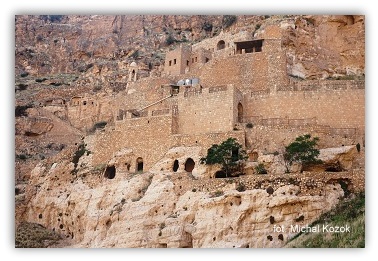 At the time of the setting sun, we climbed the road serpents to Raban Hormizd Monastery, near the town of Alqosh. It is a Christian monastery, integrated into the slope of a steep mountain, old and authentic monk's grottoes are mixed with a bit more modern church walls. Inside there was darkness, and the underground parts still had an atmosphere as if they had not changed for ages. From the terraces there was a view of the whole region, where you could see Lake Mosul with the legendary Tigris River on the horizon - too far for the details.
At the time of the setting sun, we climbed the road serpents to Raban Hormizd Monastery, near the town of Alqosh. It is a Christian monastery, integrated into the slope of a steep mountain, old and authentic monk's grottoes are mixed with a bit more modern church walls. Inside there was darkness, and the underground parts still had an atmosphere as if they had not changed for ages. From the terraces there was a view of the whole region, where you could see Lake Mosul with the legendary Tigris River on the horizon - too far for the details.
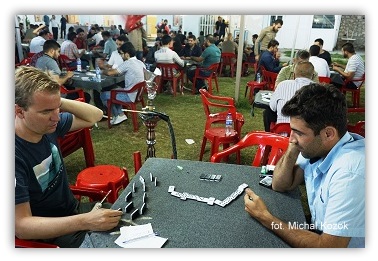 We arrived to Dohuk late, where we got to the hotel and set off to the city. Ramadan was in force, so just before sunset the streets were almost empty - and life began after the dark. Then, after the home feast the whole families came out onto the streets, it was busier with every minute. Our guide took us to the place where the locals play - that is, the men themselves, without women and children. We got our plastic table, four chairs, a water pipe and a set of dominoes to play. Karwan explained the rules to us and we started the competition - I could not stop playing, it addicted me completely. However, I had to stop taking a shisha because I felt its power in my skull - fortunately, the breaks allowed me to return to normal stage :)
We arrived to Dohuk late, where we got to the hotel and set off to the city. Ramadan was in force, so just before sunset the streets were almost empty - and life began after the dark. Then, after the home feast the whole families came out onto the streets, it was busier with every minute. Our guide took us to the place where the locals play - that is, the men themselves, without women and children. We got our plastic table, four chairs, a water pipe and a set of dominoes to play. Karwan explained the rules to us and we started the competition - I could not stop playing, it addicted me completely. However, I had to stop taking a shisha because I felt its power in my skull - fortunately, the breaks allowed me to return to normal stage :)
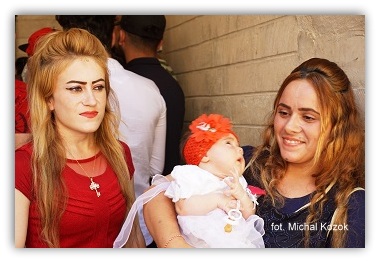

Day II
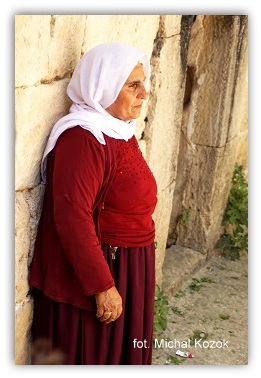 The next day we started with the breakfast, because although it was Ramadan, some of the restaurants were open with the entrance covered with a white bedsheet. We could eat, and on the street we were able to see the locals drinking the water. Ramadan is not too strict over here, but of course it pretends it is - so we did not eat so much during the day in the middle of the square.
The next day we started with the breakfast, because although it was Ramadan, some of the restaurants were open with the entrance covered with a white bedsheet. We could eat, and on the street we were able to see the locals drinking the water. Ramadan is not too strict over here, but of course it pretends it is - so we did not eat so much during the day in the middle of the square.
We left the city and almost immediately we were in the mountain scenery. Steep slopes, valleys, green-brown landscape, far to the horizon even snow-capped Turkish peaks. At some point, we started to climb up, up and up, until the road ends and a security guy stopped us. Unfortunately there is no longer allowed to enter inside the Saddam Hussein Palace and several soldiers are walking around to force the right. However, we were permitted to come near this ruined palace, beautifully located at the very top of the mountain with a 360-degree view. “The Palace”, however, is too strong word – it is remaining of something which look more like an abandoned, ruined, concrete family house, with holes in the walls and protruding wires. I managed to get inside for a few seconds and took few photos, but then the guards appeared. Still worth to get there just for the impressive view.
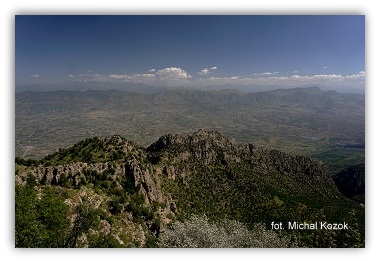
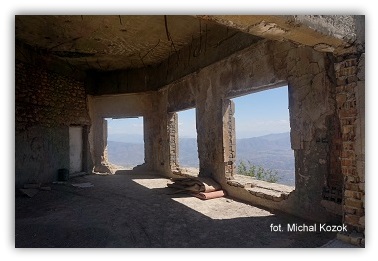
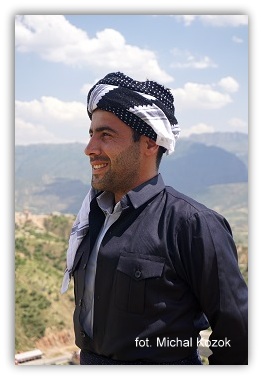 The dictator, like many of them, was a sort of unstable with mental abilities - even though he came here by Helicopter no more than once a year, of course without an announcement, so the servants had to prepare breakfast, lunch and dinner every day in case the "master" appears. Saddam had around 80 of such palaces so it is difficult to describe orders like that - but for Iraq such a leader's wishes were the slightest problem - he held power through the ruthless dictatorship and any slightest disobedience were punished in the worst possible way. He fed his people with the constant fear.
The dictator, like many of them, was a sort of unstable with mental abilities - even though he came here by Helicopter no more than once a year, of course without an announcement, so the servants had to prepare breakfast, lunch and dinner every day in case the "master" appears. Saddam had around 80 of such palaces so it is difficult to describe orders like that - but for Iraq such a leader's wishes were the slightest problem - he held power through the ruthless dictatorship and any slightest disobedience were punished in the worst possible way. He fed his people with the constant fear.
Karwan is a good tour guide, but I did not trust him as a driver. Once he missed the restaurant where we supposed to eat, then he immediately U-turned on the narrow road, regardless of the fact that it was just beyond the sharp turn - when we were sideways to the road, a truck came up - to our luck it slowed down and stopped just 10 meters in front of us. After a traditionally rich meal, where there are more dishes on the table than we can eat, we had to move on.
Our driver took us to an unofficial viewpoint on the historic Assyrian city of Amedi, 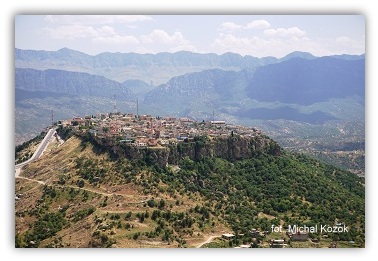 built on a plateau with the falling cliffs. Although the sun was shining straight into the lens, the view of the "sky city" was impressive. Later, we went to the citadel itself, but to tell the truth, apart from the ancient gate of Badinan, the modern town from the inside does not make the least impression - I definitely recommend the view from above.
built on a plateau with the falling cliffs. Although the sun was shining straight into the lens, the view of the "sky city" was impressive. Later, we went to the citadel itself, but to tell the truth, apart from the ancient gate of Badinan, the modern town from the inside does not make the least impression - I definitely recommend the view from above.
Then we drove few hours back to Erbil. There we said goodbye to Karwan, and we went to the local bazaar for the night life to see the concert, smoked the water pipe next to bodyguard with the gun machine, drank natural fruit juices, visited a local hairdresser, ate street food, made friends by presenting our origin same as Lewandowski, etc.
Finally, Maciek and Kamil went to the airport, and after a peaceful night I went to visit Erbil during the day. A modern Grand Mosque was ok to see, and a citadel overlooking the city. Inside the citadel we can see the remains of old clay buildings, but unfortunately with most small streets closed to visitors. Definitely, the citadel looks much more interesting from the outside than from the inside, although the view on the city from above is quite good.



Transport/meals/accommodation
 transport – you can travel by public transport, but this only works between larger cities. To see specific attractions, it is much easier to rent a car, and due to the numerous of military checkpoints - together with the local driver.
transport – you can travel by public transport, but this only works between larger cities. To see specific attractions, it is much easier to rent a car, and due to the numerous of military checkpoints - together with the local driver.
Together with two my friends we hired a local guide named Karwan Wahed, who runs one-person tourist agency Iraqi Kurdistan Tours. I can definitely recommend Karwan, good and energetic guy.
His price was USD 125 per day and it included his personal company with the organized program, travelling around by his car, the price also included fuel and pick up from the airport/hotel. In addition, we had to provide Karwan all meals and accommodation.
My friends were there two days before me, and I joined for the next two days, and the third day I spent in Kurdistan alone
Traveling by taxi to the airport was around 5-7 USD after bargain.
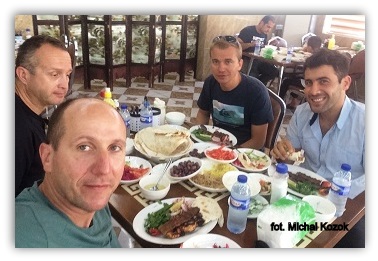 meals – tasty, but after few days you can quickly get over it because of the small variety. In the roadside restaurants, the table was richly set with various vegetables, rice, local baking, olives, etc., and the main course was usually meat, with a predominance of lamb. Sometimes a meal like this cost us only USD 20 for four persons, but sometimes twice as much.
meals – tasty, but after few days you can quickly get over it because of the small variety. In the roadside restaurants, the table was richly set with various vegetables, rice, local baking, olives, etc., and the main course was usually meat, with a predominance of lamb. Sometimes a meal like this cost us only USD 20 for four persons, but sometimes twice as much.
accommodation – in Erbil we slept in 3-star Merci Hotel. Karwan arranged a 3-bedroom with breakfast for 60 USD, and I paid USD 30 for single room at the last night. Booking.com takes a bit more. In Dohuk we slept in 4-star Kristal Hotel and we paid USD 60 for our team of four (no breakfast).

 flight – Since March 2018 international Erbil airport is opened again. The most popular connection is from Istanbul, but of course you can get there from other destinations, including very popular Doha or Dubai. In the low season, during the promotion of Pegasus, the return ticket from Italy or Czech Republic is for around 300 Euro. Of course, during the European holidays, such a ticket is much more expensive, even twice more.
flight – Since March 2018 international Erbil airport is opened again. The most popular connection is from Istanbul, but of course you can get there from other destinations, including very popular Doha or Dubai. In the low season, during the promotion of Pegasus, the return ticket from Italy or Czech Republic is for around 300 Euro. Of course, during the European holidays, such a ticket is much more expensive, even twice more.
weather – the dry season is from May to October. It is also the period of the highest temperatures, reaching above 30 degrees during the day.
currency – Iraqi dinar, the best exchange rate has US dollar
visa – free of charge at the arrival. However, with the Kurdish stamp, we cannot enter the proper Iraq.
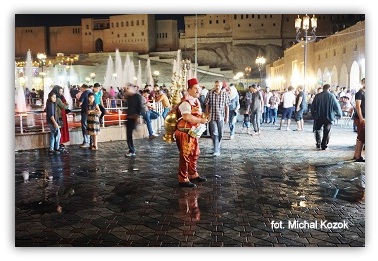
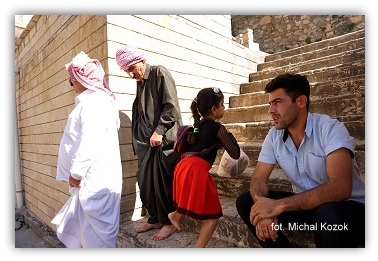



![]()











![]()


![]()







